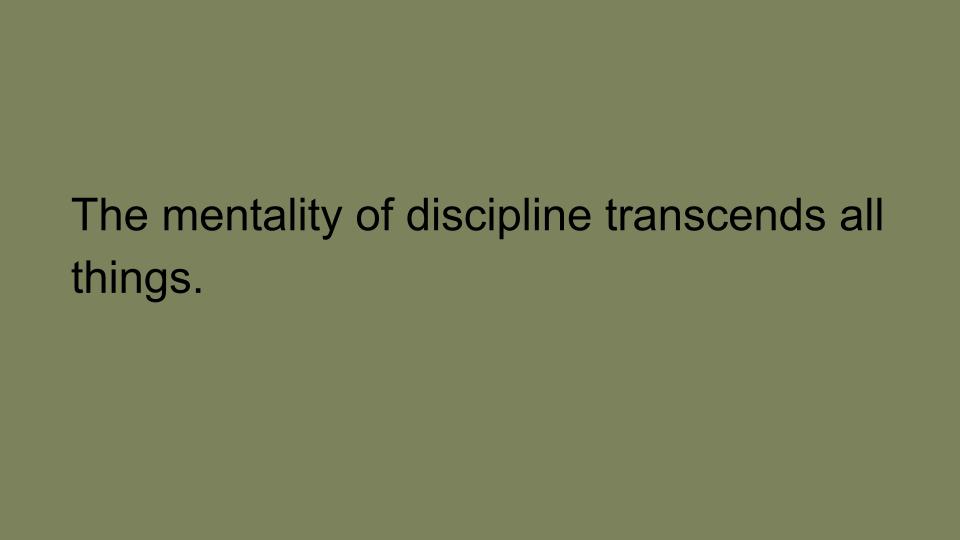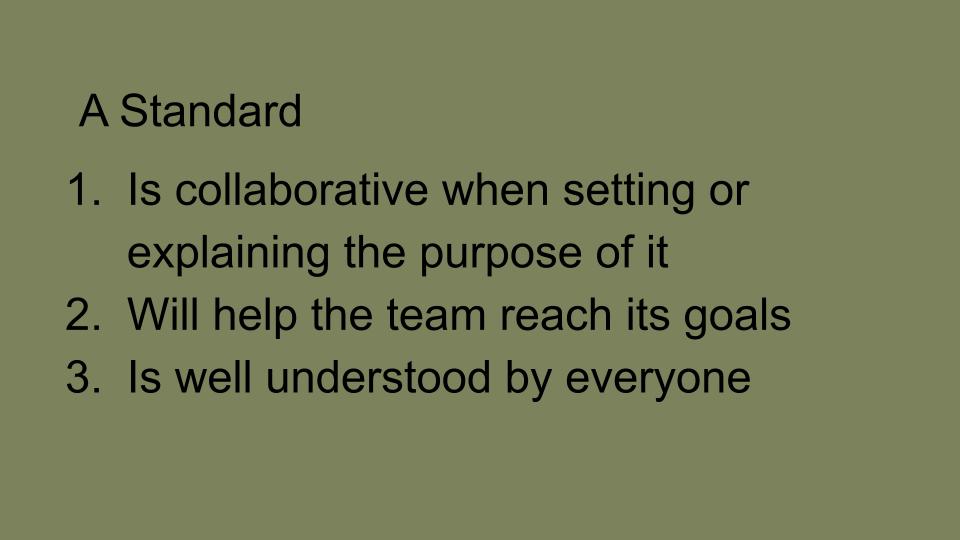SUMMARY
-
Consistency + A Standard = Discipline
-
Set standards collaboratively with the team and make sure the expectation to meet them is well understood
-
Consistency is driven by leadership supervision of the standard
WAR
Imagine that you are a Marine infantryman. It’s over 100 degrees in the middle of an Afghan summer. You’ve spent the last two days searching dozens of compounds in Taliban controlled territory. The 60 pounds of weight on your back is crushing your shoulders. You’ve barely slept and are dehydrated and hungry.
To search a compound, you take a long stick with a hook on the end and scrape the ground around the entrance to confirm there is not an improvised explosive device hidden under the dirt. The next compound you’re tasked with clearing looks like a family lives there and doesn’t seem threatening. Your exhausted mind justifies not scraping the entryway. You instead do a quick scan with your eyes to see if there are any visual disturbances in the ground. You don’t see anything. You take a step over the threshold of the entryway.
You wake up in a hospital in Germany seven days later with both of your legs missing.
In combat the smallest things make a huge difference. Did you coordinate your plan, did you clean your rifle, did you double check your gear, did you scrape every single doorway for boobytraps or? Everything adds to your chance to win and survive. Discipline is wards off complacency by keeping you prepared.
Whoever has the most discipline will slowly gain an edge on their enemy. An organization can have better weapons and more technology, but the true difference maker is an unbreakable will to fight and the discipline to execute every day.
The mentality of discipline
Males in the Marine Corps are expected to shave everyday. Shaving has almost no tactical value at all. The only reason for doing it, is that it gives your gas mask a tighter seal. A vast majority of the time we operate without gas masks, so that rationale rarely applies.
So why do we force ourselves through the highly inconvenient task of shaving when we’re in the field, it’s 20 degrees outside, and we have no warm water?
The reason is discipline.

Shaving everyday is the Marine Corps standard. We don’t drop our standards no matter the circumstance. When a team stops shaving, next they’ll stop cleaning their weapons, then they’ll stop prepping their gear, then they’ll stop checking every entryway for improvised explosive devices.
If a person or a team holds themselves to high standards in one area it’s much more likely they’ll hold high standards in other areas as well.
The mentality of discipline transcends all things.
What is discipline?
I define discipline as consistently doing the work to maintain the standard. This definition gives two parts to the equation of discipline; consistency and the standard.
The more consistent you are, the more disciplined you are. The higher your standards, the more disciplined you are. If you’re very consistent and have high standards, then you are extremely disciplined.

You can be very consistent but barely meet standard. In that case, you are just disciplined enough. You can also lack consistency but exceed standards through intermittently putting out extreme effort. In this case, you’d likely meet standard but would not be very disciplined.
The Marine Corps is known for having a high amount of discipline. The reason is because our leaders set high standards and consistently hold us to them. There are very few exceptions to our basic standards. If you show that you can’t meet the level of discipline required by our organization you will be removed. It’s not personal, it’s just business. Our currency is discipline and everyone has to pay up.
BUSINESS
A disciplined team sets a standard and meets that standard consistently. If you want more discipline, set a higher standard and get more consistency.
Setting standards
You cannot have discipline without an established standard. A standard can be very simple. This team does a report everyday. For this shift, you show up at the exact time. Before a major strategic decision, we will have a discussion with this team.
Once that standard is set, the expectation to meet that standard needs to be clearly communicated. Communicating expectations stops anyone from saying they didn’t know. It also gives them an opportunity to ask clarifying questions and raises risks to their ability to meet the standard. If the standard has been defined, and the expectation communicated, then leaders and other teammates should feel comfortable holding everyone to that standard.
If a team deeply believes that maintaining the standard is fair, and supports the success of the team, then the team will start to self regulate. If the entire team, not just the leadership, is holding everyone to the standard, then discipline across the team will be perpetually maintained.

The key is that the team deeply believes in the standards. Ideally for belief to occur, everyone should contribute to the formation of the standards. This allows each team member to suggest tweaks to the standard based on their experience. The more collaborative the setting of the standards is, the higher the belief in them will be.
In some circumstances, the leadership needs to establish a standard with little contribution from the team or a new team member arrives after the standard has been set. In those cases, the leadership team, and the more experienced team members, should thoroughly explain why that standard is important. If the reason behind the standard is understood, then belief in it can be maintained.
Overall, the intent is that everyone believes in the purpose of the standards and understands them thoroughly.
Driving consistency
Leadership supervision is the most effective way to drive consistency. If the team knows that a leader will consistently inspect to see if the standard is being met then they are more likely to maintain the standard. The leadership team needs to have the moral courage to correct people when the standard isn’t met. They’ll also need to be willing to support people who aren’t meeting the standard. A good team works to bring everyone into standard because they believe that will help the team succeed.
A more advanced way to drive consistency is a visual tracking system. The outcome of the tracking is a manual or automated metric. This metric is used to drive more consistency and accountability across the team. It can be as simple as everyone self reporting if they met the standard that day on a whiteboard, or as advanced as a dashboard that produces up to the minute data. The book “4 Disciplines of Execution” explains visual tracking systems very well.

A tracking system allows you to see who exceeds and struggles to meet standards. If someone consistently exceeds standards they should be publicly praised. The people who do not meet standards should be privately supported to help get them within standard. It will quickly become clear if a team member is not a good fit, if they cannot meet standard even with maximum support from the team. The team needs to succeed and fail together.
If a team is consistently meeting standards, the overall goals of the team should be met. This is another metric that needs to be tracked. If goals are being met, then belief in the standard will grow stronger.
Conclusion
If you lead a team and want them to be more discipline ask yourself:
- Does the team have standards for their work?
- Is the expectation to meet those standards well understood by everyone?
- Is the consistency of meeting the standards being tracked or supervised?
Those questions will help to identify the gaps in the equation of discipline. Once you know the gap then you can fill it by setting standards, clearly explaining them and then holding your team to them.

0 Comments